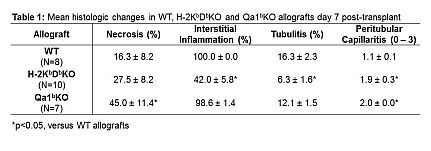Second Role of Donor MHC Class I: Prevention of Microcirculation Injury and Alternative Macrophage Activation, The
University of Alberta, Edmonton, Canada
Meeting: 2013 American Transplant Congress
Abstract number: 65
We previously showed that IFNG is necessary to stabilize mouse kidney allografts during T cell-mediated rejection (TCMR): lack of IFNG, IFNG receptors, or the class I peptide loading mechanism (B2M, TAP1), triggers an altered TCMR phenotype: microcirculation congestion and expression of alternative macrophage activation (AMA) transcripts. We hypothesized that these stabilizing effects may reflect a specialized role of donor MHC class I products interacting with receptors on effector T cells.
Using histology and gene expression microarrays, we compared kidney allograft donors deficient in MHC class Ia (H-2Kb and H-2Db) or MHC class Ib (Qa1b) products to wild-type (WT) allografts in WT hosts.
Compared to WT allografts, H-2Kb/Db deficient allografts developed altered rejection lesions, increased lymphocytes in the capillaries and decreased lymphocytes in the interstitium, suggesting failure of transendothelial movement. Qa1b deficient allografts also developed increased peritubular lymphocytes (Table 1). Both H-2Kb/Db and Qa1b deficient allografts displayed decreased TCMR transcripts (defined in rejecting human kidneys) but increased expression of selected AMA transcripts e.g. Mrc1, Arg1 (Figure 1).
Thus the lack of donor MHC class Ia and Ib products leads to decreased mononuclear transendothelial migration (decreased interstitial infiltrate) and decreased expression of T cells genes in the kidney; with increased mononuclear cells in the capillaries, and increased AMA.
These findings suggest the class I system has a second role in TCMR: IFNG-induced class I and Qa1 deliver signals to inflammatory cells to facilitate transendothelial migration and suppress AMA, possibly by interactions with inhibitory receptors on T cells (e.g. NKG2A/CD94). This in turn inhibits cytotoxic mechanisms and allows T cells to cross the endothelium into the interstitial space, sparing the microcirculation.


To cite this abstract in AMA style:
Venner J, Halloran P. Second Role of Donor MHC Class I: Prevention of Microcirculation Injury and Alternative Macrophage Activation, The [abstract]. Am J Transplant. 2013; 13 (suppl 5). https://atcmeetingabstracts.com/abstract/second-role-of-donor-mhc-class-i-prevention-of-microcirculation-injury-and-alternative-macrophage-activation-the/. Accessed July 18, 2025.« Back to 2013 American Transplant Congress
